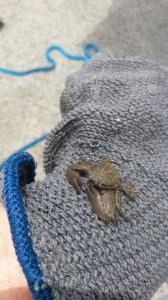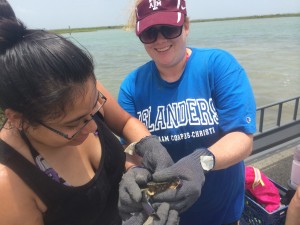Who We Are
What We Did
I went to Port Aransas with Avery to help her collect crabs. We took a boat to the marina near the ferry so we could get to the oyster reefs where we would be collecting all the crabs. Her goal was to get 70 medium-large mud crabs for her experiment and 100 small crabs for another person’s lab.
One of the most important aspects to this collection trip was safety. The oyster reefs are sharp and the sand can give way suddenly so it was very important to wear good tennis shoes that would withstand the sharp edges of the oyster clusters, and wear sturdy gloves when handling them and collecting the crabs.
The rest of the gear we used primarily were special knives used specifically to open up oysters or cut into large clusters of them to extract the crabs, bait buckets, bubblers and buckets to keep the crabs in.
These are the types of gloves we used and a baby stone crab that decided to hitch a ride on my glove.
When we arrived at the oyster reef, Avery gave everyone a knife and bait bucket to put the crabs in and then showed us how to catch them. She demonstrated by holding a crab down and grabbing it on the sides to pick it up so the crab couldn’t use it’s claws. She also showed us how to use the knife to pry apart the oyster clusters the crabs like to hide in or use it to move it to a better position. We then set off to search for more crabs.
At first it was very difficult for us to find them. The crabs are very similar in coloring to the oyster shells so we had trouble sometimes figuring out what we were seeing and the water would get cloudy very fast once the sediment and mud got disturbed. Natalie (the other ETEAMS member who was with us) and I shared a knife and tag teamed on the crab search till we both got the hang of it. She pointed out that the crabs tend to have purple on their claws and that made it a lot easier for me to learnt to spot them.
Once we got enough large crabs and put them in their designated buckets, we focused on collecting the small ones. These weren’t as difficult because most of the time, all you had to do was pick any oyster cluster up and you’d see several scurrying out of sight. We had to use the knife a lot more for these because they liked to hide in the cracks.
We put the small ones in these trays to float towards the top of the buckets so it wouldn’t be so hard to get them all out of the bucket later.
Overall everything went really smoothly and nobody had any serious trouble with the crabs. They got feisty sometimes and I’m glad those gloves held up because the crabs were not happy being manhandled and kept trying to pinch me. It was a lot of hard work but it was a great experience I’m glad I got to participate in.
What We Learned
One of the first lessons I learned was preparation. Avery was very organized and it really showed because everything went as planned and we didn’t run into any problems. There is a lot of work that goes into planning these trips and making sure all the proper equipment is brought, that it works, that everyone has what they need and to take into account many other factors.
Another major lesson is safety. We had to think and go over boat safety, navigating the oyster reef, and handling the crabs. Avery made sure to explain everything and answer any questions or give suggestions so we could avoid any injuries. It really struck me how important it is to establish rules and clear guidelines so we could have relatively stress free trip and be able to focus on our jobs.
I also learned more about the behavior of crabs and their environment. Handling them all day and exploring their habitat allowed me to gain unique experiences and fueled my curiosity to learn more about these creatures. This type of trip and activity really allows each individual to learn about something new and be some place they haven’t been before.
Questions We Have
I would like to know what happened to the crabs in the lab after we collected them.
I also would like to know how our presence affected the environment. A broader question is how do scientists balance necessary work and jobs with preserving the environment they are working in?
Connections to Teaching
I could use this experience to supplement a lesson on crabs and their environment or the oyster reef. I think bringing in real life experiences would make it more relate-able to students and give them a different perspective.
Another lesson I could draw from this is field trip safety and planning. Avery provided me with a great example of how to plan effectively and give clear instructions. It also allowed me to reflect on other factors I might not have considered before and gave me a better idea of what types of safety issues I would need to work out.
Another lesson I could draw from this is how to properly handle live animals that I might bring into the classroom or in the lab and how to treat wild animals that a student could encounter. Corpus offers a lot of access to different marine animals and I think it’s important that students know what to do when they come across them and make sure that they keep themselves protected and the marine life unharmed.




